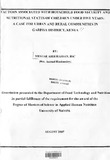| dc.description.abstract | This was comparative study of factors affecting food security and nutritional status of under fiveyears-
old children in rural and urban community of Garissa District was conducted. A total of
302 children from 302 households selected by simple random sampling were studied. Data were
collected using structured questionnaires and anthropometry.
The main objective of the study was to determine factors that are associated with household food
security and nutritional status of the children under the age of five years in Garissa District.
Urban and rural livelihoods and lifestyles obviously differ. The study found that while levels of
key determinants of malnutrition, such as expenditure, living conditions, or education, may
differ between rural and urban areas, the nature of the determinants and the magnitudes of their
effects are very nearly the same, but differ greatly when it comes to food security. On the other
hand, these differences in levels do not necessarily express themselves in differences in
outcomes: the level of food security is roughly the same in rural and urban areas, while levels of
stunting, wasting and underweight differ quite dramatically.
What explains these results? For nutritional 'status of children, most of the urban-rural difference
does appear due to differences in the levels of critical determinants, such as in income or
mother's educational level. For example, stunting of children 0-60 months old is higher in rural
than in urban areas (23 percent versus 20 percent, respectively). Wasting of children 0-60 months
old is also much more prevalent in rural than in urban areas (26.,6 percent versus 20.3 percent,
respectively). Prevalence of underweight for rural and urban areas was 32.5 percent and 25.7
percent, respectively. There were, however, no significant differences between urban and rural
v
areas on the average levels of the indices. The study results shows that an average income of $
21 buys the rural households, which constitutes 75% of,the study population were living below
poverty line as per cut off point set by Unicef which is $30. per household. The percentage of
total household expenditure spent on food is among food security indicators used by most
economists. On average 65.4% of the total expenditure including health was spent on food alone
suggesting, a food insecurity indicator problem among the studied household. The significant
positive association between nutritional status and income p-value of 0.01, 0.04 and 0.04
stunting in rural areas, wasting and urban areas, and wasting and rural areas, respectively, were
observed.
Within the context of the significant variables in the study, this difference in urban-rural levels of
stunting, wasting and underweight is explained by noting that expenditure levels and maternal
education are much lower in rural areas. Expenditure levels of food items in ruraI areas are only
about half those in urban areas, and 90.4 percent of rural mothers are illiterate or have no
education at all, while a lower 85.1 percent of urban mothers do not have any education .. The
prevalence of malnutrition decreases with the level of education of the mother. Stunting in urban
areas seems to be high up to 20.6% for children whose mothers never went to school and drops
to 12.5% for children whose mothers went to primary school. The same trend was observed for
rural areas. However, there is no significant evidence in between (p 0.05) to suggest significant
positive association between the level. of education of the mother and all the nutritional indicators
On the other hand, the levels of some critical determinants of food security are also very
different between rural and urban areas, but levels of food security, as measured by calories,
protein and iron are much the same. Iron and protein levels are almost the same in urban and
rural areas, while calorie levels are significantly higher in urban than in rural households.
Household size is higher in rural areas than urban areas. Expenditure levels are higher in urban
areas than rural areas.
None of the households visited met the required daily carolies requirement. Overal only 12.5%
of the visited households met the required daily protein and iron intake. With respect to protein,
only 8.3% of the household visited from rural areas were found to be food secure. Of the
households visited in the urban areas, 25% were found to be food secure. This means that there
are more food secure households in urban than rural areas.
Factors associated with nutritional status are; income activities, ownership of livestock,
ownership of houses, types of houses, expenditure on food items and cough/cold.
Factors associated with food security are; marital status of the mother, per capita expenditure and
family size. It is concluded that household food security is worsened by small household size,
level of education of the mother and lower per caita expenditure. It is recommended that there is
need·for communities to foster activities that increase household income, which will in turn
improve on household income and expenditure on child care, and by implication child nutritional
status. Different income groups (youth, women) need to be encouraged so that income may
inturn be expanded. Women's education is an important factor in improving children's
nutritional status. In the long term ,improving girls education and women literacy and job skills
will raise household income. | en |

